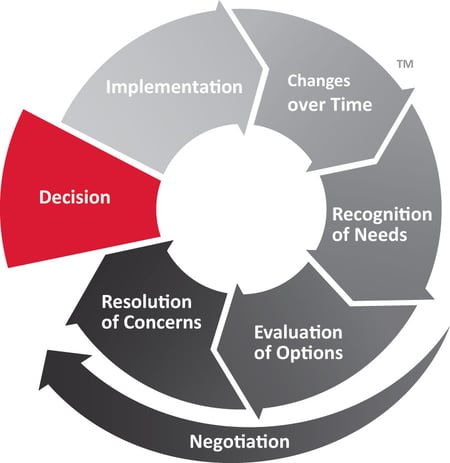If, as we have done, you spend decades observing, analysing and addressing human behaviour in the commercial world, and then something unexpected comes along to shift the world on its axis, what then? Specifically, what will change in customer organisations’ behaviour as they consider whether or not to make substantial purchases in a time of extreme uncertainty and locked budgets?

Helping customers around the classical Buying Cycle™ assumes a natural progression of the persuasive process in what we might call normal times. In summary, that sequence leading up to decision is:
But clearly these are not normal times.
If there is one thing that our work over 50 years has demonstrated it’s that asking insightful questions and then letting the customer talk about their problems and the impacts of those problems as they see them is massively effective.
At the Changes Over Time stage, the Covid-19 outbreak is one massive externally caused change that, depending on their sector, could cause an existential threat (if, for example, they’re a conference organiser or anyone in that supply chain) or a massive opportunity (as toilet roll manufacturers and video streaming services are probably finding). It will, in the short to medium term, overshadow most other considerations, and customers might well be paralysed, or at least daunted, by the prospect. One thing is certain, this is one change over time you won’t have to pull to the front of anyone’s mind – it will already be there.
Skilled sellers here would avoid jumping in with any ready-made or quickly concocted answers. Instead, they’ll try to understand, as forensically and unemotionally as possible, how customers see the business and personal dislocation affecting different aspects of their operations. The same skilled sellers will consider whether any needs start to emerge that they could meet – possibly in innovative ways.
So, in Recognition of Needs, our skilled seller will focus questions on those impacts, all the time thinking about, but not yet describing, what the right solution could look like and how they could provide it. People who talk and ask about the future state, are often the most persuasive.
In selling a product or service that directly tackles the business effects of virus outbreak (for us it would be the ability to move physical training to virtual, for another company it might be an innovative logistics solution, or a short term finance offering) it will be persuasive if seller and buyer can co-create and articulate a narrative that sees the problems giving way to better outcomes. Everyone foresees doing something different, and envisages a conceivable tangible payoff. That’s the point at which products, services, or solutions get proposed in specific terms: when everyone involved in the conversation can clearly see how and where they’d help, and the buyer is ready to act.
If a seller can encourage a customer to get to this point in the Buying Cycle™, then once the buyer reaches the Evaluation of Options stage they’ll be asking themselves, “how can this supplier and their solution, more than anyone else I can see in the landscape, help us to mitigate and improve our situation?”. Before the seller asks any question of the customer, this requires careful reflection. Customers won’t just be thinking normal thoughts about whether the technical features are attractive and relevant, whether the system is reliable and a good fit, whether a supplier is good to work with and so on. Of course, those thoughts will still be there – anything that customers spend money on in abnormal times must also meet needs in normal, business-as-usual times. But they’ll be more focussed on moving solutions that will get them through the present crisis up their corporate spending agenda – and they’ll be wondering if the solution they are currently evaluating really does that.
I’d even suggest that, at the moment, customers might perhaps be bringing thoughts that normally crop up in Resolution of Concerns forward into their evaluation stage. More than ever, it’s about risk. “Can I even be committing funds to a major investment at a time when our own income streams are not secure?”; “What is the impact on me personally of choosing the wrong option at a time when some jobs might be at risk?”. If the seller can revisit the original benefits and guidelines that made the case persuasive and the supplier credible in the first place, in a genuine, consultative way, that will help. So will re-treading with the customer again how the solution in question mitigates rather than enhances risk – and perhaps show how and where other customers are already finding this to be the case.
Now, more than ever, buyers will be anxious about the consequences of their actions. Sellers need to uncover, clarify and help resolve these anxieties in full co-operation with the buyer. Otherwise, there will be no buyer. But get the approach right – from starting consultatively to positioning yourself as the right people in their particular crisis – and you’ll be one step ahead. In the long run, there might even be more business there than you thought.
Huthwaite International
Harry Brearley House
6 Fox Valley Way
Fox Valley
Sheffield
S36 2AE
+44 (0)1709 710081
enquiries@huthwaiteinternational.com
Copyright 2024 Huthwaite International | All Rights Reserved Huthwaite International | Change Behaviour. Change Results.™